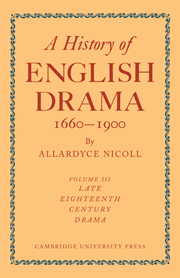Appendix A - THE THEATRES: 1750–1800
Published online by Cambridge University Press: 05 March 2012
Summary
The contractions used for the various theatres in the previous 1 volume on early eighteenth-century drama have been employed in this survey as well. It has not been thought necessary here to enter into the minutiœ of the stage history of the period; those may be studied in the many volumes of theatrical reminiscences which abound at this time.
Drury Lane (D.L.). This theatre was under the management of Garrick until his retirement in 1776, when his share was sold for £35,000 to Linley, Sheridan and Dr Ford. Although Sheridan was nominally manager of the Company till 1809, J. P. Kemble was the actual director from 1788 onwards. The old D.L. theatre was abandoned on 4/6/1791, the company playing first at the King's Theatre in the Haymarket and later (19/9/1793) at the Little Theatre in the Haymarket. A new Theatre Royal at D.L. was built by Holland and opened on 12/3/1794. It was a much larger structure, capable of holding over 2500 spectators. The proscenium opening was 43 feet wide and the height 38 feet.
Covent Garden (C.G.). Under the management of John Rich till his death in 1761, when it passed into the hands of Bencroft and John Beard, who devoted himself to comic opera. In Aug. 1767 the shares passed to Thomas Harris, John Rutherford, George Colman and William Powell. In 1777 this arrangement was broken through the departure of George Colman, who took over the management of the Little Theatre in the Haymarket. The theatre was altered in 1782, and greatly enlarged for the season 1792–3.
- Type
- Chapter
- Information
- A History of English Drama 1660-1900 , pp. 229 - 230Publisher: Cambridge University PressPrint publication year: 1952



